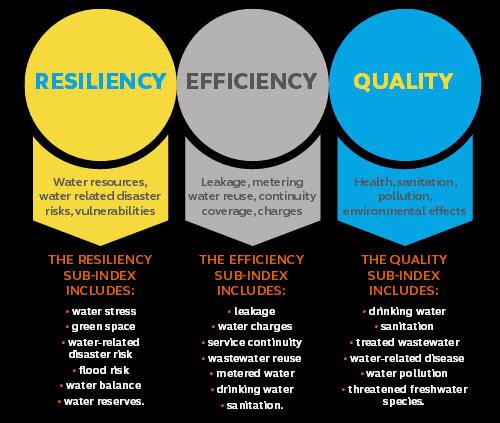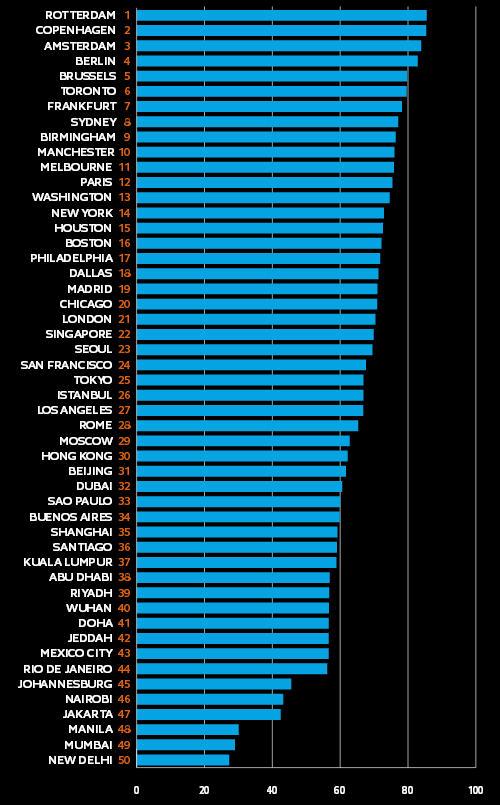U.S. vs. The World In Water Sustainability

By Kevin Westerling,
@KevinOnWater
Yes, America cleaned up at the Olympics this summer, but how does the U.S. fare on the world stage when it comes to water resiliency, efficiency, and quality?
These three criteria, and how cities are positioned to harness water for long-term success, were considered for the 2016 Sustainable Cities Water Index released by Arcadis in August. Fifty global cities were studied, including nine from the U.S. In order of finish, the U.S. cities were Washington D.C., New York, Houston, Boston, Philadelphia, Dallas, Chicago, San Francisco, and Los Angeles.
Far from dominant in this arena, the U.S. had a high rank of 13 and a low of 27 — above average on the whole, but trailing a host of European cities as well as Toronto, Sydney, and Melbourne. The Arcadis report, led by Global Director of Water and Cities John Batten, notes that the challenges bringing down the rank of the U.S. cities are largely a product of climate change. Seven of the nine stateside cities finished in the bottom half for resiliency, a 'sub-index' category of the report measuring vulnerability to natural disasters and extreme weather. The low scores reflecting this trend counteracted high scores in the other sub-index categories; for example, L.A. ranked second for efficiency while Chicago and Philly ranked second and third, respectively, for quality.
The report, which was developed in partnership with the Centre for Economics and Business Research (CEBR), enumerates some of the issues related to each of the sub-indices, shown in the following graphic.

Here’s the breakdown of the U.S. cities’ performances, overall and by sub-index, followed by the complete city list.
Washington, D.C.: #13
Resiliency: 20; Efficiency: 16; Quality: 12
Led by CEO and General Manager George Hawkins, who was recently named to President Obama’s National Infrastructure Advisory Council (NIAC), DC Water has spearheaded innovation by incorporating cutting-edge, energy-efficient processes for enhanced nutrient removal with anammox bacteria and biosolids management via thermal hydrolysis, in addition to a massive tunnel project to rid the city of combined sewer overflows.
Still, the report notes some areas of improvement needed to lift DC’s overall water index rating. As with many old cities, aging pipeline infrastructure and the funding to repair and replace it is an ongoing challenge, as Hawkins attests. Arcadis recommends an effective asset management program as “vital” to assuring long-term sustainability of infrastructure.
New York: #14
Resiliency: 27; Efficiency: 14; Quality: 7
New York ranked high on quality, much to do with its source water derived from the Catskill/Delaware and Croton watersheds, and so pristine as to not require filtration. The region’s water is disinfected at the world's largest UV disinfection facility, which is also acknowledged as one of the best.
The lagging resiliency rating is tied to vulnerability to weather events, evidenced by the destruction wrought by Superstorm Sandy. The report’s authors estimate that New York would incur at least $500 million in storm- and flood-related damage over the next half-century without any action, but thankfully that’s not the case. The East Side Coastal Resiliency project, a collaborative of government agencies, business leaders, and private investors, is among the initiatives created to fortify infrastructure and protect essential services in anticipation of more superstorms.
Houston: #15
Resiliency: 34; Efficiency: 11; Quality: 10
The Arcadis study states that “Houston’s annual average rainfall is nearly ideal for the area, reducing overall water stress”; however, another study by the National Oceanic and Atmospheric Administration (NOAA) warns that “the differences between average demand and average supply are relatively small, so slight shifts in either supplies or demands can trigger stress” in the U.S. West, including Houston. With an eye on the threat, Houston is very efficient with its water management and also ranks high for quality, although Arcadis notes that Houston consumers pay more per unit of water as a proportion of income than any other U.S. city on their list.
In addition to drought, the city is at risk for severe storms and hurricanes. Investment is needed to upgrade the urban drainage system along with other infrastructure, resulting in a low resiliency ranking relative to other cities.
Boston: #16
Resiliency: 28; Efficiency: 19; Quality: 6
Once chided for dirty water, Boston made a $3.8 billion investment to reduce combined sewer overflow (CSO) into the Boston Harbor, focusing on improvements to the Deer Island Sewage Treatment Plant. The quality of many of the city’s recreational waters, including the Charles River, has turned around significantly due to such ongoing and sometimes unconventional efforts.
Northeast weather conditions keep Boston at risk of flood, made worse by a lack of green space, Arcadis reports. Initiatives are underway, such as Climate Ready Boston, to help stem the tide and improve the city’s resiliency.
Philadelphia: #17
Resiliency: 25; Efficiency: 29; Quality: 3
Philadelphia has made tremendous strides in “greening” the city to soak up stormwater and reduce CSO, creating the award-winning “Green City, Clean Waters” initiative to convert the urban landscape — including sidewalks, streets, roofs, and parking lots — from impermeable to permeable, or at least more permeable. In fact, the Philadelphia Water Department (PWD) asserts that the program “will reduce the stormwater pollution entering waterways by a stunning 85 percent,” notes Arcadis. The former head of PWD, Harold Neukrug, talked with Water Online about the initiative here.
Like its colonial cohorts, Philadelphia has a looming, expensive problem with aging infrastructure. Arcadis states that the city’s “most critical risk over the next five-year period is upgrading aging infrastructure with limited capital,” relaying information from PWD’s own budget report.
Dallas: #18
Resiliency: 37; Efficiency: 18; Quality: 11
Dallas is a city seemingly bursting at the seams with population, but has proactively taken steps to ensure water availability through conservation, smart meters, and reservoir construction.
Like Houston, “Big D” faces the threat of both drought and floods, has a susceptible infrastructure, and bears a resiliency score that reflects those concerns.
Chicago: #20
Resiliency: 36; Efficiency: 27; Quality: 2
“Chicago is close to having almost no pollution in its freshwater sources,” affirms Arcadis, resulting in the second-best quality ranking globally (narrowly edged by Toronto). Read here how the Metropolitan Water Reclamation District of Greater Chicago (MWRD) upgraded its oldest wastewater treatment facility and leveraged the world’s largest reservoir to curb CSOs. Furthermore, MWRD is leading a change in operations and culture (as well as nomenclature) from “wastewater treatment plant” to “water resource recovery facility.” This includes phosphorus capture and recovery and a plan to be energy-neutral by 2023.
Chicago’s resiliency and efficiency rank in terms of its correlation to pipeline infrastructure could improve in future years, Arcadis suggests, due to “one of the most ambitious water and sewer line replacement programs, replacing 100 miles of pipes per year” and a volunteer metering program (incentivized with rate guarantees) designed to increase consumer awareness and reduce leakage.
San Francisco: #24
Resiliency: 44; Efficiency: 7; Quality: 23
The strength of San Francisco’s efficiency ranking (second among U.S. cities) is attributable to its wastewater reuse initiatives and its non-revenue water program, which includes community outreach that is often creative — even sexy.
Meanwhile, “San Francisco is close to completing a $5 billion investment to make its water supply more reliable and resilient,” states Arcadis, so that shortcoming is being addressed. Geography plays its part: the Pacific Ocean and San Francisco Bay present natural flood risk, while earthquakes are also of concern. For quake and drought resiliency, the San Francisco Public Utilities Commission (SFPUC) launched the Regional Groundwater Storage and Recovery Project within the Hetch Hetchy Regional Water System.
Los Angeles: #27
Resiliency: 48; Efficiency: 2; Quality: 21
As the second-most populous city in the U.S., Los Angeles has made plenty of headlines for supply and demand concerns in the midst of epic drought. Water efficiency has become a necessity, and L.A. has done well with it, ranking second in Arcadis’ efficiency sub-index to Copenhagen. Statewide water-use restrictions have been lifted since El Niño helped fill reservoirs in northern California, but L.A. remains steeped in drought and conservation remains a social mandate among its residents (see #droughtshaming). Arcadis also gives strong marks for L.A.’s attempts to retain local water through reuse, non-revenue water reduction, large storage capacity, and stormwater capture.
Despite those efforts, Arcadis points out that 85 percent of the city’s water is currently imported from more than 100 miles away. That need will be mitigated as local water supply projects are implemented over the next four to 10 years, but resiliency and sustainability will continue to be strained as long as drought exists in the region.
Sustainable Cities Water Index – Overall Rankings

As seen above, Europe stands atop the Sustainable Cities Water Index podium with a preponderance of high-ranking cities. The U.S. also performed admirably — worthy of a silver or bronze medal in Olympic parlance (Australia deserving recognition as well) — but with obvious room to step up its game.
